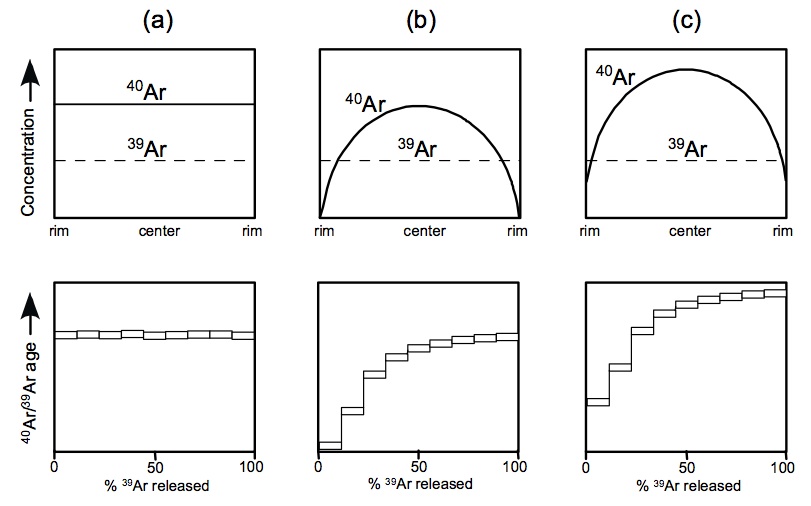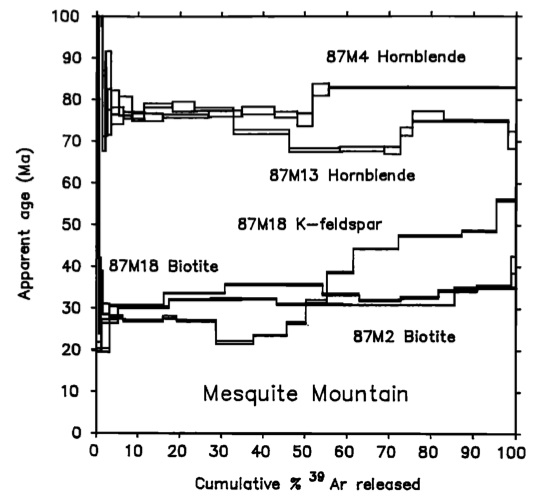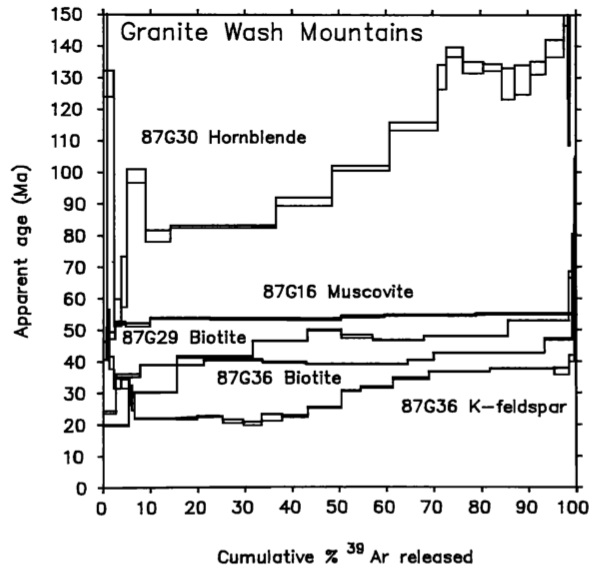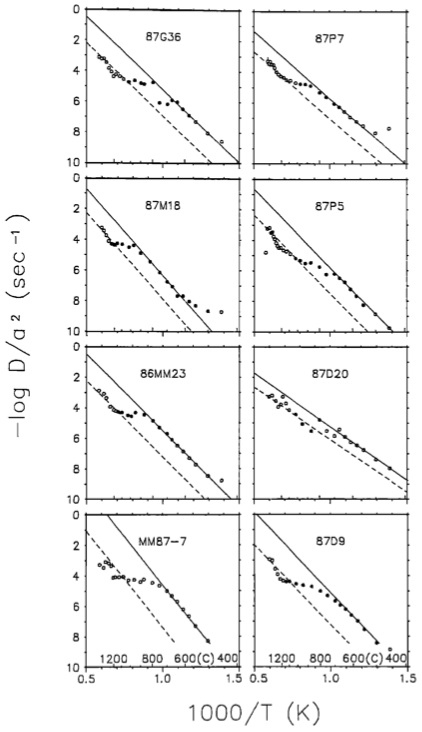40Ar/39Ar dating is a major method that researchers have used to understand the structural evolution of the Maria Fold and Thrust Belt. Argon-argon dating works because potassium-40 decays to argon-40 with a known decay constant. However, potassium-40 also decays to 40Ca much more often than it decays to 40Ar. This necessitates the inclusion of a branching ratio (9.54) in the "age equation," below:
 (equation 1)
(equation 1)Here, t is time and λ is the total decay constant for 40K. This led to the formerly-popular potassium-argon dating method. However, scientists discovered that it was possible to turn a known proportion of the potassium into argon by irradiating the sample, thereby allowing scientists to measure both the parent and the daughter in the gas phase. There are several steps that one must take to obtain an argon-argon date:
First, the desired mineral phase(s) must be separated from the others. Common phases to be used for argon-argon dating are white micas, biotite, varieties of potassium feldspar (especially sanidine because it is potassium-rich), and varieties of amphibole.
Second, the sample is irradiated along with a standard of a known age. The irradiation is performed with fast neutrons. This transforms a proportion of the 39K atoms to 39Ar. After this, the sample is placed in a sealed chamber and heated to fusion, typically with a high-powered laser. This releases the argon, both 40Ar and 39Ar, which are measured by a mass spectrometer. After correcting for excess argon produced by other reactions during the irradiation, with the assumption that non-nucleogenic atmospheric 36Ar is related to 40Ar with a ratio of 1/296, the ratio of radiogenic argon-40 to argon-39 is found. The amount of 39Ar is proportional to the amount of 39K in the sample, and the ratio of 40K to 39K is constant in nature. Commuting these, geologists can calculate the amount of the parent 40K nuclide.
In going from 40K (in equation 1, above) to 39Ar, the 9.54 must be replaced by a constant "irradiation parameter", J.
 (equation 2)
(equation 2)This irradiation parameter is given by:
 (equation 3)
(equation 3)Here, 39K/40K is the approximately constant potassium ratio, ∆ is the amount of time that the sample was irradiated, Φ is the neutron flux during the irradiation, E is the energy at which the irradiation takes place, σ is the neutron capture cross section for the for the 39K(n,p)39Ar reaction (the reaction that changes 39K into 39Ar), and 40Ar/39Ar is the measured argon ratio. Because the sample is irradiated along with a standard of known age (t), and the argon ratio is measured, the standard provides the value of the irradiation parameter, J. This can be used to solve equation 2 for the sample.
A major advantage of the argon-argon method is that the sample can be heated incrementally. This process, known as "step heating", provides additional information on the age of the sample. Reheating events and diffusion of argon from the boundaries of the grain can result in lower 40Ar/39Ar ages near the boundaries of the grain. A more representative age of initial cooling is given by the "plateau age", where the edge effects give way to a constant 40Ar/39Ar date. Sometimes, when a large amount of argon has been lost, this is not possible. In these cases, the age of the first batch of argon released is the age of the reheating event, and the age of the last argon released is the minimum age of initial crystallization. It is also common that only the argon released from a crystal early-on is problematic, and that a plateau is reached in the argon that is released in later stages of the analysis. This plateau must be used with caution, however, because it could have been lowered by later events and therefore may represent a minimum constraint on the age of crystallization.
 |
| Hypothetical profiles of argon concentrations through the grain, and associated step-heating results. (a) A constant concentration profile indicates no diffusion or later heating events. This yields a steady plateau age. (b) Recent diffusive loss of 40Ar yields a staircase-type profile. (c) A reheating event yields another staircase-like profile; the 0% value is the age of the reheating event, and the 100% value is the minimum age of initial crystallization of the sample. From Harrison and Zeitler (2005). |
(Source: Harrison and Zeitler, 2005)
Application to the Maria Fold and Thrust Belt
Knapp and Heizler (1990) use argon-argon thermochronometry to date the thermal history of the Maria Fold and Thrust Belt. In doing so, they find that basement-involved deformation of the crust around 80–90 Ma caused regional heating of the crust. From latest Cretaceous through Tertiary time, they record uplift and slow cooling of the rocks, at a rate of 5–10 K/Ma. Oligocene and Miocene extension along low-angle normal faults, associated with metamorphic core complex emplacement, produced the final thermal signal.
40Ar/39Ar closure temperatures are a function of crystal diffusional length-scale, composition and structure, and cooling rate. To address the first of these, Knapp and Heizler (1990) select multiple mineral phases to analyze. This allows them to observe the passage of metamorphic amphiboles (~500ºC), muscovite (375ºC), biotite (325ºC), and K-feldspar (~125–300ºC: Copeland and Harrison, 1990) pass through their respective closure temperatures. This gives Knapp and Heizler (1990) multiple observation points to observe the temperature history of the MFTB rocks.
  |
| 40Ar/39Ar step-heating results from Mesquite Mountain and the Northern Granite Wash Mountains. Knapp and Heizler (1990) took samples from the migmatitic Mesquite Gneiss in the Mesquite Mountain locality and from both the hanging wall and foot wall of multiple structures in the Northern Granite Wash Mountains. At Mesquite Mountain, the plateau ages for the hornblende indicate closure at around 80 Ma, the initial phase of thrusting and uplift. Biotites and potassium feldspar have 0% 39Ar intercept ages around 20-30 Ma, indicative of early Miocene cooling during extension and unroofing in the Colorado River Extensional Corridor. The approximate intercept age of the hornblende in Granite Wash Mountains is likewise ~80 Ma, indicating that this grain saw a pulse of reheating at that time. 87G16 is 55.2 Ma, indicating continued cooling. The argon loss profiles within the other phases suggest a Miocene overprint on previously-cooled samples. From Knapp and Heizler (1990). |
Knapp and Heizler (1990) provide further evidence for rejuvenated Miocene unroofing from the complexities of K-feldspar closure temperatures. They show that there are two different domains within the K-feldspars that have different diffusivities. This causes them to become closed to argon diffusion at different temperatures. One of these domains completely anneals at a higher temperature, and the other remains an open system until rapid cooling at ~21 Ma, interpreted to be related to Miocene unroofing and extension.
